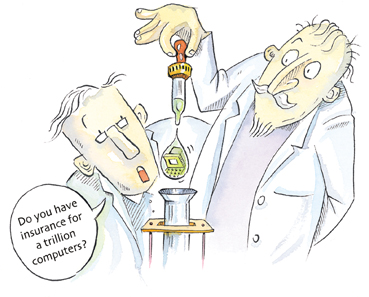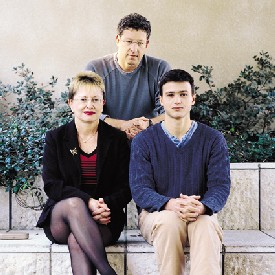Are you a journalist? Please sign up here for our press releases
Subscribe to our monthly newsletter:

This is the vision that inspires a team of Weizmann Institute scientists, who have recently made an important early step toward its realization, creating the first autonomous biological nanocomputer. Reported in Nature, as many as a trillion such computing devices can work in parallel in one drop of water in the lab of Prof. Ehud Shapiro of the Computer Science and Applied Mathematics Department and the Biological Chemistry Department. The devices collectively perform a billion operations per second with greater than 99.8% accuracy per operation while requiring less than a billionth of a watt of power.
The nanocomputer created is computationally very limited and too simple to have immediate applications, however it may pave the way to future computers with unique biological and pharmaceutical applications able to operate within the human body. 'It will probably take decades,' says Shapiro. 'But we believe this vision is realizable. The living cell contains incredible molecular machines that manipulate information-encoding molecules such as DNA and RNA in ways that are fundamentally very similar to computation. Since we don't know how to effectively modify these machines or create new ones just yet, the trick is to find naturally existing machines that, when combined, can be steered to actually compute.'
Shapiro challenged Ph.D. student Yaakov Benenson to do just that: to find a molecular realization of one of the simplest mathematical computing machines - a finite automaton that detects whether a sequence of 0's and 1's has an even number of 1's.
Benenson came up with a solution using DNA molecules and two naturally occurring DNA-manipulating enzymes: Fok-I and Ligase. Operating much like a biological editing kit, Fok-I functions as a chemical scissors, slicing DNA into a specific pattern, whereas the Ligase enzyme seals DNA molecules together.
The nanocomputer can be programmed to perform several simple tasks, depending on the software molecules mixed into the solution. The software molecules can be used to create a total of 765 software programs. Several of these programs were tested in the lab, including the 'even 1's checker,' as well as programs that check whether in a list of 0's and 1's, the 0 comes before the 1 in every case, or whether it both starts with a 0 and ends with a 1.
How do DNA strands come to contain the symbols 0 and 1? DNA strands are usually depicted as a scroll of recurring 'letters,' in varied combinations, which represent DNA's constituents (four chemical bases known as A, T, C, and G). The nanocomputer created by Shapiro's team uses these four DNA bases to encode the input data as well as the program rules underlying the computer 'software.' The team decided that the letter pattern 'CTGGCT' in the input molecule would signify 1 and 'CGCACG' would signify 0.
In addition to having two symbols, the input molecule, when mixed with hardware and software molecules, also has two states. When the hardware molecule Fok-I, recognizes a symbol and 'cuts' DNA, it leaves it with one strand longer than the other, resulting in a single-strand overhang called a 'sticky end' (see diagram). Since Fok-I makes its incision at the site of the symbol, the sticky end is what remains of the symbol. Fok-I may leave the symbol's 'head' or 'tail' attached. These are the two possible states. A computing device that has two possible states and two possible symbols is called a two-state, two-symbol finite automaton.
Two molecules with complementary sticky ends can temporarily stick to each other (a process known as hybridization). In each processing step the input molecule hybridizes with a software molecule that has a complementary sticky end, allowing the hardware molecule Ligase to seal them together using ATP molecules as energy.
Then comes Fok-I, which cleaves the input molecule again, in a location determined by the software molecule. Thus a sticky end is again exposed, encoding the next input symbol and the next state of the computation. Once the last input symbol is processed, a sticky end encoding the final state of the computation is exposed and detected - again by hybridization and ligation - by one of two 'output display' molecules. The resulting molecule, which reports the output of the computation, is made visible to the human eye in a process known as gel electrophoresis.
Though their potential as miniature 'doctors' may be decades away from realization, these devices, if further advanced, could, be used to screen DNA libraries in vitro. This in itself could contribute to the future development of gene therapies tailored to individuals according to their genetic make-up. Both visions have a long way to go, but these small beginnings are harbingers of a much enhanced quality of life.
This study was conducted in collaboration with Prof. Zvi Livneh, Dr. Tamar-Paz Elizur, and Dr. Rivka Adar of the Weizmann Institute's Biological Chemistry Department and Prof. Ehud Keinan of the Technion Israel Institute of Technology's Chemistry Department.
In 1954 researchers at the Weizmann Institute of Science built the first computer in Israel, and one of the first computers worldwide, which they fondly named WEIZAC. Thirty years later, silicon chip computers routinely functioned at a rate that was thousands and millions of times faster than WEIZAC.
